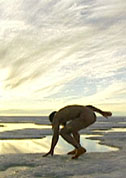
Movie Guru Rating:

Comment
on this review
| |

The Fast Runner puts the 'story' back in 'storytelling'
by Jesse Fox Mayshark
In last Sunday's New York Times, film critic Neal Gabler wrote an interesting essay about what he called "faux movies." He was talking about big summer movies, action films and comedies and even dramas, that don't so much present the traditional stuff of entertainment—i.e., a story, characters, emotional engagement—as short-hand versions of all those things.
"Instead of character development in movies or full-bodied jokes in situation comedies," Gabler wrote, "viewers get a set of signals, a kind of code, that advises them how to respond without having to expend the effort, however minimal, that real entertainment demands. You see or hear the signal and you respond as if you were getting the real thing."
He's onto something. I think of it as an empty-stomach feeling. You sit in front of a screen and you know you're supposed to respond in certain ways—with a laugh or a tear or a gasp—because the rhythm of the dialogue or the background music or the look on the actors' faces tells you so. But beneath the surface reaction, there's a void, an absence in the place where emotions come from. You respond to the stimulus, even though you don't care about it. After a while, you might even confuse it with the real thing.
Until, that is, you see something like The Fast Runner (Atanarjuat). This marvelous movie has gotten a fair amount of press for its exoticism—it is the first film written and performed in the native Inuit tongue, Inuktitut. It is adapted from age-old Inuit folklore. And its director, Zacharias Kunuk, filmed it on location in frigid North American settings with lightweight digital video equipment and an Inuit cast.
All of that would make it interesting as anthropology. But anthropology isn't entertainment. What makes The Fast Runner work as a movie is the same thing that undoubtedly kept it alive through generations of Inuit storytellers—it's a good tale, told well. Through a fascinating cultural prism, it presents themes as universally human as anything in Shakespeare, Homer or the Bible. Its particular world is strange to outsiders, and exhilarating in its strangeness. But its characters are driven by things we hardly need subtitles to understand: love, envy, pride, loyalty.
The story is set 2,000 years ago, and in a way it may be the most convincing historical epic ever made. Because so much of Inuit life remained unchanged for so long, Kunuk (who won the Camera D'Or at this year's Cannes festival for best first feature) didn't have to do much to recreate the lives of his ancestors. The basic stuff of daily Inuit life—the animals they hunted for food and clothing, the snow and rocks and other materials they used to construct shelters—can still be had easily. The simplicity of the setting frees the performers from the things that often sink historical dramas: awkward period dress, gestures toward old manners of speech and expression, etc. The dialogue may or may not resemble Inuit speech of 100 A.D., but the feelings expressed are eternal. (For example, I don't know if "asshole" is a literal interpretation of an Inuktitut epithet, but it's clearly true to the spirit of the scene.)
The story concerns two brothers, Armaqjuaq (Pakka Innukshuk) and Atanarjuat (Natar Ungalaaq). They are best friends and two of the best hunters in their nomadic tribe. Atanarjuat, good-looking and playful, is a favorite with the young women. He flirts in particular with a pretty girl named Atuat (Sylvia Vualu). But Atuat's father has already promised her to the chief's ill-tempered son, Oki (Peter-Henry Arnatsiaq). Tensions between Oki and Atanarjuat build until they finally settle the matter with ceremonial (and brutal) combat. Atanarjuat wins, to Atuat's delight. But that's just the beginning of a chain of actions that eventually engulf the entire camp. All of it has a metaphoric overlay—an old woman narrating the tale blames the trouble on the arrival of a spirit she calls simply "the evil one."
The cast is uniformly terrific, and Kunuk gives generous attention to all of his characters. The bond between the brothers, the tribe's complex gender roles, the relationships between spouses and parents and children—all of it is rendered in straightforward, human terms. The people in this movie are so full-bodied, so smart and funny and complex and conflicted, they show up most Hollywood "characters" for the pre-fab constructions they are.
Kunuk has the understated rhythm of a natural storyteller, and he greatly prefers showing to telling. Although he was obviously aware that much of his film's audience would be non-Inuit, he uses context rather than exposition to present his culture. The details enrich and enliven the story, but they never overwhelm it. The movie has the same high-contrast, grainy look of other digital video transfers, but even that works to its advantage. It gives a quasi-documentary feel that heightens the realism and makes the occasional hint of the supernatural that much more surprising. (The climactic confrontation with the "evil one" is genuinely unnerving.)
In his essay, Neal Gabler says that the modern crop of fake movies "exist largely as a system of reminders of what we once experienced when we watched real entertainment—movies and television shows that engaged us and made us feel." The Fast Runner, on the other hand, is a welcome reminder that not everyone has forgotten how to do that.
[ Editor's Note: The Fast Runner is only playing through Thursday, Aug. 8.]

August 8, 2002 * Vol. 12, No. 32
© 2000 Metro Pulse
|